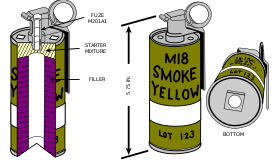Grenade


Agrenadeis anexplosive weapontypically thrown by hand (also calledhand grenade), but can also refer to ashell(explosiveprojectile) shot from the muzzle of arifle(as arifle grenade) or agrenade launcher.A modern hand grenade generally consists of anexplosive charge( "filler" ), adetonatormechanism, an internalstrikerto trigger the detonator, an arming safety secured by a transport safety. The user removes the transport safety before throwing, and once the grenade leaves the hand the arming safety gets released, allowing the striker to trigger aprimerthat ignites afuze(sometimes called the delay element), which burns down to the detonator and explodes the main charge.
Grenades work by dispersing fragments (fragmentation grenades),shockwaves(high-explosive,anti-tankandstun grenades), chemicalaerosols(smokeandgas grenades) orfire(incendiary grenades). Their outer casings, generally made of a hardsynthetic materialor steel, are designed toruptureandfragmenton detonation, sending out numerous fragments (shardsandsplinters) as fast-flying projectiles. In modern grenades, a pre-formed fragmentation matrix inside the grenade is commonly used, which may be spherical, cuboid, wire or notched wire. Mostanti-personnel(AP) grenades are designed to detonate either after a time delay or on impact.[1]
Grenades are often spherical, cylindrical, ovoid or truncated ovoid in shape, and of a size that fits the hand of an average-sized adult. Some grenades are mounted at the end of a handle and known as "stick grenades". The stick design providesleveragefor throwing longer distances, but at the cost of additional weight and length, and has been considered obsolete by western countries since theSecond World WarandCold Warperiods. A friction igniter inside the handle or on the top of the grenade head was used to initiate the fuse.
Etymology
[edit]The wordgrenadeis likely derived from the French word spelled exactly the same, meaningpomegranate,[2]as the bomb is reminiscent of the many-seeded fruit in size and shape. Its first use in English dates from the 1590s.[3]
History
[edit]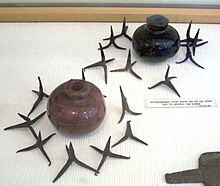
Pre-gunpowder
[edit]

Rudimentary incendiary grenades appeared in theEastern Roman (Byzantine) Empire,not long after the reign ofLeo III(717–741).[4]Byzantine soldiers learned thatGreek fire,a Byzantine invention of the previous century, could not only be thrown byflamethrowersat the enemy but also in stone and ceramic jars.[4]Later, glass containers were employed.
Gunpowder
[edit]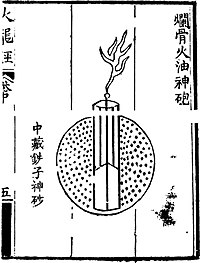
InSong China(960–1279), weapons known as 'thunder crash bombs' (Chấn thiên lôi) were created when soldiers packedgunpowderinto ceramic or metal containers fitted with fuses. A 1044 military book,Wujing Zongyao(Compilation of Military Classics), described various gunpowder recipes in which one can find, according toJoseph Needham,the prototype of the modern hand grenade.[5]

The shells (pào) are made of cast iron, as large as a bowl and shaped like a ball. Inside they contain half a pound of 'divine fire' (shén huǒ,gunpowder). They are sent flying towards the enemy camp from an eruptor (mu pào), and when they get there a sound like a thunder-clap is heard, and flashes of light appear. If ten of these shells are fired successfully into the enemy camp, the whole place will be set ablaze...[8]
Grenade-like devices were also known in ancient India. In a 12th-century Persian historiography, theMojmal al-Tawarikh,[9]aterracottaelephant filled with explosives set with afusewas placed hidden in the van and exploded as the invading army approached.[10]
The firstcast-ironbombshells and grenades appeared in Europe in 1467, where their initial role was with the besieging and defense of castles and fortifications.[11]A hoard of several hundred ceramic hand grenades was discovered during construction in front of a bastion of the Bavarian city ofIngolstadt,Germany, dated to the 17th century. Many of the grenades retained their original black powder loads and igniters. The grenades were most likely intentionally dumped in the moat of the bastion prior to 1723.[12]
By the mid-17th century, infantry known as "grenadiers"began to emerge in the armies of Europe, who specialized in shock and close quarters combat, mostly with the usage of grenades and fierce melee combat. In 1643, it is possible thatgrenadoswere thrown amongst the Welsh atHolt Bridgeduring theEnglish Civil War.The wordgrenadewas also used during the events surrounding theGlorious Revolutionin 1688, where cricket ball-sized (8.81 to 9 in (224 to 229 mm) in circumference) iron spheres packed with gunpowder and fitted with slow-burning wicks were first used against theJacobitesin the battles ofKilliecrankieandGlen Shiel.[13]These grenades were not very effective owing both to the unreliability of their fuse, as well inconsistent times to detonation, and as a result, saw little use. Grenades were also used during theGolden Age of Piracy,especially during boarding actions; pirateCaptain Thompsonused "vast numbers of powder flasks, grenade shells, and stinkpots" to defeat two pirate-hunters sent by theGovernor of Jamaicain 1721.[14]
Improvised grenades were increasingly used from the mid-19th century, the confines oftrenchesenhancing the effect of small explosive devices. In a letter to his sister, Colonel Hugh Robert Hibbert described an improvised grenade that was employed by British troops during theCrimean War(1854–1856):[15]

We have a new invention to annoy our friends in their pits. It consists in filling empty soda water bottles full of powder, old twisted nails and any other sharp or cutting thing we can find at the time, sticking a bit of tow-in for a fuse then lighting it and throwing it quickly into our neighbors' pit where it bursts, to their great annoyance. You may imagine their rage at seeing a soda water bottle come tumbling into a hole full of men with a little fuse burning away as proud as a real shell exploding and burying itself into soft parts of the flesh.
In March 1868 during theParaguayan War,the Paraguayan troops used hand grenades in their attempt to board Brazilianironclad warshipswith canoes.[16]
Hand grenades were used on naval engagements during theWar of the Pacific.[17][18]
During theSiege of Mafekingin theSecond Boer War,the defenders used fishing rods and a mechanical spring device to throw improvised grenades.[19]
Improvised hand grenades were used to great effect by the Russian defenders of Port Arthur (nowLüshun Port) during theRusso-Japanese War.[20]
Development of modern grenades
[edit]
Around the turn of the 20th century, the ineffectiveness of the available types of hand grenades, coupled with their levels of danger to the user and difficulty of operation, meant that they were regarded as increasingly obsolete pieces of military equipment. In 1902, the BritishWar Officeannounced that hand grenades were obsolete and had no place in modern warfare. But within two years, following the success of improvised grenades in the trench warfare conditions of the Russo-Japanese War, and reports fromGeneral Sir Aylmer Haldane,a British observer of the conflict, a reassessment was quickly made and theBoard of Ordnancewas instructed to develop a practical hand grenade.[21]Various models using apercussion fuzewere built, but this type of fuze suffered from various practical problems, and they were not commissioned in large numbers.[20]
Marten Hale, known for patenting theHales rifle grenade,developed a modern hand grenade in 1906 but was unsuccessful in persuading theBritish Armyto adopt the weapon until 1913. Hale's chief competitor wasNils Waltersen Aasen,who invented his design in 1906 in Norway, receiving a patent for it in England. Aasen began his experiments with developing a grenade while serving as a sergeant in theOscarsborg Fortress.Aasen formed the Aasenske Granatkompani in Denmark, which before the First World War produced and exported hand grenades in large numbers across Europe. He had success in marketing his weapon to the French and was appointed as aKnight of the French Legion of Honourin 1916 for the invention.[20]
The Royal Laboratory developed theNo. 1 grenadein 1908. It containedexplosive materialwith an ironfragmentationband, with an impactfuze,detonating when the top of the grenade hit the ground. A long cane handle (approximately 16 inches or 40 cm) allowed the user to throw the grenade farther than the blast of the explosion.[21]It suffered from the handicap that the percussion fuse was armed before throwing, which meant that if the user was in a trench or other confined space, he was apt to detonate it and kill himself when he drew back his arm to throw it.[22]
Early inWorld War I,combatant nations only had small grenades, similar to Hales' and Aasen's design. The Italian Besozzi grenade had a five-second fuze with a match-tip that was ignited by striking on a ring on the soldier's hand.[23]
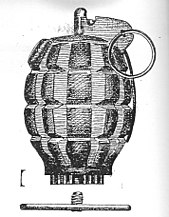
William Mills,a hand grenade designer fromSunderland,patented, developed and manufactured the "Mills bomb"at the Mills Munition Factory inBirmingham,England in 1915, designating it the No.5. It was described as the first "safe grenade". They were explosive-filled steel canisters with a triggering pin and a distinctive deeply notched surface. This segmentation is often erroneously thought to aidfragmentation,though Mills' own notes show the external grooves were purely to aid the soldier to grip the weapon. Improved fragmentation designs were later made with the notches on the inside, but at that time they would have been too expensive to produce. The external segmentation of the original Mills bomb was retained, as it provided a positivegripsurface. This basic "pin-and-pineapple" design is still used in some modern grenades.[20]
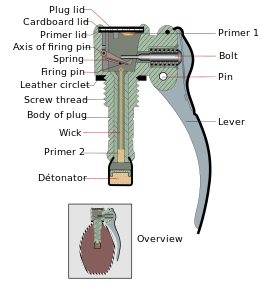
After theSecond World War,the general design of hand grenades has been fundamentally unchanged, with pin-and-lever being the predominant igniter system with the major powers, though incremental and evolutionary improvements continuously were made. In 2012,Spränghandgranat 07(shgr 07, "Blast hand-grenade 07" ) was announced as the first major innovation in the area of handgrenades since theGreat War.[24][25][26]
Developed by Ian Kinley atFörsvarets Materielverk(FMV), shgr 07 is a self-righting, jumping hand grenade containing some 1900 balls that covers a cone 10 metres in diameter with the centre about 2 metres in height. This minimize the dangers outside the lethal zone as there is little to no random scattering of fragments from the blast..[27][28][29]
Explosive grenades
[edit]Fragmentation
[edit]Fragmentation grenades are common in armies. They are weapons that are designed to disperse fragments on detonation, aimed to damage targets within the lethal and injury radii. The body is generally made of a hard synthetic material or steel, which will provide some fragmentation as shards and splinters, though in modern grenades a pre-formed fragmentation matrix is often used. The pre-formed fragmentation may be spherical, cuboid, wire or notched wire. Most explosive grenades are designed to detonate either after a time delay or on impact.[1]
Modern fragmentation grenades, such as the United StatesM67 grenade,have a wounding radius of 15 m (49 ft) – half that of older style grenades, which can still be encountered – and can be thrown about 40 m (130 ft). Fragments may travel more than 200 m (660 ft).[30]
High explosive
[edit]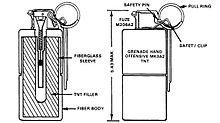
These grenades are usually classed as offensive weapons because the effective casualty radius is much less than the distance it can be thrown, and its explosive power works better within more confined spaces such asfortificationsorbuildings,where entrenched defenders often occupy. The concussion effect, rather than any expelled fragments, is the effective killer. In the case of the USMk3A2,the casualty radius is published as 2 m (6 ft 7 in) inopenareas, but fragments and bits of fuze may be projected as far as 200 m (660 ft) from the detonation point.[31]
Concussion grenades have also been used asdepth charges(underwater explosives) around boats and underwater targets; some like the USMk 40concussion grenade are designed for use against enemy divers andfrogmen.Underwater explosions kill or otherwise incapacitate the target by creating a lethal shock wave underwater.[32]
TheUS Army Armament Research, Development and Engineering Center(ARDEC) announced in 2016 that they were developing a grenade which could operate in either fragmentation or blast mode (selected at any time before throwing), the electronically fuzedenhanced tactical multi-purpose(ET-MP) hand grenade.[33]
Anti-tank
[edit]
During the Great War, handgrenades were frequently used by troops, lacking other means to defend against enemy tanks threatening to over-run the position, to various success. The Interwar period saw some limited development of grenades specifically intended to defeat armour, but it was not until the outbreak of WWII serious efforts were made. While there were infantry anti-tank weapons available, they were either not ubiquitous enough, ineffective or both. Anti-tank grenades were a suitable stopgap to ensure a rudimentary capability for every squad to be used for self-defence. Oncerocket-propelledshaped chargesbecame available in greater numbers, anti-tank hand grenades became almost obsolete. However, they were still used with limited success in theIraqi insurgencyin the early 2000s against lightly-armouredmine-resistant ambush protected(MRAP) vehicles, designed for protection only againstimprovised explosive devices,[34]as well as drone ordnance in Ukraine 2022–2024.
Incendiary
[edit]DuringWorld War IIthe United Kingdom used incendiary grenades based onwhite phosphorus.One model, theNo. 76 special incendiary grenade,was mainly issued to theHome Guardas an anti-tank weapon. It was produced in vast numbers; by August 1941 well over 6,000,000 had been manufactured.[35]
Sting
[edit]Sting grenades, also known as stingball or sting ball grenades,[36]are stun grenades based on the design of the fragmentation grenade. Instead of using a metal casing to produce fragmentation, they are made from hard rubber and are filled with around 100 rubber or plastic balls. On detonation, these balls, and fragments from the rubber casing explode outward in all directions as reduced lethality projectiles, which may ricochet.[37]It is intended that people struck by the projectiles will receive a series of fast, painful stings, without serious injury. Some types have an additional payload ofCS gas.[38]
Sting grenades do not reliably incapacitate people, so they can be dangerous to use against armed subjects.[39]However, they can sometimes cause serious physical injury, especially the rubber fragments from the casing.[37]: 88 People have lost eyes and hands to sting grenades.[40]
Sting grenades are sometimes called "stinger grenades", which is agenericized trademarkas "Stinger" is trademarked byDefense Technologyfor its line of sting grenades.[37]: 83–84
Chemical and gas
[edit]Chemical and gas grenades burn or release a gas, and do not explode.[1]
Practice
[edit]
Practice or simulation grenades are similar in handling and function to other hand grenades, except that they only produce a loud popping noise and a puff of smoke on detonation. The grenade body can be reused.[41][42]Another type is the throwing practice grenade which is completely inert and often cast in one piece. It is used to give soldiers a feel for the weight and shape of real grenades and for practicing precision throwing. Examples of practice grenades include the K417 Biodegradable Practice Hand Grenade by CNOTech Korea.[43][44]
Igniters
[edit]
When using a hand grenade, the objective is to have the grenade explode so that the target is within its effective radius while keeping the thrower out of the same. For this reason, several systems has been used to trigger the explosion.
Impactwas the first used, with fragile containers of Greek fire that ruptured when landing. Later impact fuzes contained some kind of sensitive explosive to either initiate the main charge directly, or set off a primer charge that in turn detonates the main charge. This turned out to present significant drawbacks; either the primer is so sensitive that unintended and premature ignition happens, while a more stable substance often fails to set off the grenade when landing in softer ground, not seldom even allowing the targeted troops to hurl the grenade back. Thus, the only significant use of impact fuzes since WWI has been in anti-tank grenades.
Fuze-delayedgrenades is the predominant system today, developed from the match-fuzes that were hand-lit in the early grenades. From there, two sub-groups were developed:friction-ignitorswhere a cord is pulled or a cap is twisted to ignite the delay-fuze like on the German Stielhandgranate; the other beingstrike-orpercussion-ignitorswhere the user either hit the cap before the throw like on the JapaneseType 10 grenade,or have a spring-loaded striker hit the cap after the grenade is released like theMills bombwith the latter being predominant since WWII. There is also an alternative technique of throwing, where the grenade is not thrown immediately after the fuze is ignited, which allows the fuze to burn partially and decrease the time to detonation after throwing; this is referred to as "cooking". A shorter delay is useful to reduce the ability of the enemy to take cover, throw or kick the grenade away and can also be used to allow a fragmentation grenade to explode into the air over defensive positions.[46]
Concerned with a number of serious incidents and accidents involving hand grenades, Ian Kinley at the SwedishFörsvarets materielverkidentified the two main issues as thetime-fuze's burntimevariation with temperature (slows down in cold and speeds up in heat) and thesprings,the striker spring in particular, coming pre-tensioned from the factory by mechanism designs that had not changed much since the 1930s. In 2019, a new mechanism, fully interchangeable with the old ones, was adopted into service. The main difference, apart from a fully environmentally stable delay, is that the springs now are twist-tensioned by the thrower after the transport safety (pin and ring) has been removed, thus eliminating the possibility of unintentional arming of the hand grenade.[47]
Cultural impact
[edit]Manufacturing
[edit]Modern manufacturers of hand grenades include:
- Agenzia Industrie della Difesa[48](Italy)
- Diehl[49](Germany)
- Mecar[50](Belgium)
- Rheinmetall[51](formerly Arges, Austria)
- Ruag[52](Switzerland)
- Nammo[53](Norway)
- Instalaza[54](Spain)
- Solar Industries[55](India)
- MKEK(Turkey)[citation needed]
See also
[edit]References
[edit]Inline citations
[edit]- ^abcLevy, Michael (November 11, 2023).grenade: military technology.Encyclopaedia Britannica.Archivedfrom the original on November 21, 2023.RetrievedNovember 21,2023.
- ^Chisholm, Hugh,ed. (1911)..Encyclopædia Britannica.Vol. 12 (11th ed.). Cambridge University Press. p. 578.
- ^"grenade (n.)".Online Etymology Dictionary.Retrieved2017-01-05.
- ^abForbes, Robert James (1993).Studies in Ancient Technology.Leiden.ISBN978-90-04-00621-8,p. 107
- ^Needham, Joseph (1994).Science and civilization in China:Vol. 5; "Part 6: Chemistry and chemical technology; Military technology: missiles and sieges". Cambridge University Press.ISBN0-521-32727-X
- ^Tanner, Harold Miles (30 March 2009).China: A History.Hackett Publishing. p. 204.ISBN978-0-87220-915-2.
First known illustration of a fire lance and a grenade
- ^Bodde, Derk (1987).Chinese Ideas About Nature and Society: Studies in Honour of Derk Bodde.Hong Kong University Press. p. 300.ISBN978-962-209-188-7.Retrieved15 February2013.
- ^Needham, Volume 5, 264.
- ^"Grenade"atEncyclopædia Iranica
- ^Oppert, Gustav Salomon; Vaiśaṃpāyana. Nītiprakāśikā; Śukra. Śukranīti; Weber, Albrecht (1880).On the weapons, army organisation, and political maxims of the ancient Hindus, with special reference to gunpowder and firearms.Oxford University. Madras, Higginbotham. p. 64.
We read: "that the Brahmans counselled Hal to have an elephant made of clay and to place it in the van of his army, and that when the army of the king of Kashmir drew nigh, the elephant exploded, and the flames destroyed a great portion of the invading force. Here we have not only the simple act of explosion, but something very much like a fuze, to enable the explosion to occur at a particular time."
- ^Needham, Volume 5, Part 7, 179.
- ^Franzkowiak, Andreas; Wenzel, Chris (2016). "Explosives aus der Tiefgarage – Ein außergewöhnlicher Keramikgranatenfund aus Ingolstadt".Sammelblatt des Historischen Vereins Ingolstadt(in German).125:95–110.ISSN1619-6074.
- ^Cramb, Auslan (23 February 2004)."Battlefield gives up 1689 hand grenade".Scotland Correspondent.Archivedfrom the original on 2022-01-11.
- ^Headlam, Cecil (1933).America and West Indies: January 1719(January 1719 ed.). London: British History Online. pp. 1–21.Retrieved28 July2017.
- ^"The National Archives, records of the UK government".Letters of Hibbert, Hugh Robert, 1828–1895, Colonel, ref. DHB/57 – date: 14 June 1855.Archived fromthe originalon 2007-09-27.Retrieved2006-08-09.
- ^Barros, Aldeir Isael Faxina (2021-05-31)."Abordagem aos Encouraçados no Tagy (1868)".Navigator(in Portuguese).17(33): 98–114.ISSN2763-6267.
- ^Contador Zelada, Andrés (2011).Las armas menores en la Guerra del Pacífico.[Chile]: [Legatum Editores].ISBN978-956-9242-08-3.OCLC1318788961.
- ^"Granadas de mano en combate naval".Revista de Marina.Retrieved2023-04-02.
- ^Standingwellback (2020-02-29)."IEDs in the Boer War".Standing Well Back.Retrieved2023-04-02.
- ^abcdSaunders, Anthony (2012).Reinventing Warfare 1914–18: Novel Munitions and Tactics of Trench Warfare.A&C Black. pp. 25–40.ISBN978-1-4411-2381-7.
- ^abSaunders, Anthony (1999).Weapons of the Trench War.Sutton Publishing. p. 2.ISBN0-7509-1818-7.
- ^Hogg, Ian.Grenades and mortars.Ballantines Illustrated History of the Violent Century. Weapons book, no. 37.
- ^"How the Modern Grenadier is Armed".Popular Science.January 1919. p. 14.Retrieved2017-01-05– viaGoogle Books.
- ^FMV announcement
- ^Officerstidningen nr 7, 2019, sid 8
- ^Succé för svensk handgranat, Aftonbladet 2013-09-05, Jan Huss
- ^FMV announcement
- ^Officerstidningen nr 7, 2019, sid 8
- ^Succé för svensk handgranat, Aftonbladet 2013-09-05, Jan Huss
- ^"M67 Fragmentation Hand Grenade".Federation of American Scientists.Retrieved2017-01-05.
- ^"Center for Army Lessons Learned - Thesaurus".Archived fromthe originalon 2012-09-26.Retrieved2012-07-21.
- ^Dockery 1997, p. 188.
- ^"US Army builds 'ambidextrous' grenade".BBC News.20 September 2016.Retrieved20 September2016.
- ^Schogol, Jeff (October 20, 2009)."MRAPs modified to deflect RKG-3 anti-tank grenades".Stars and Stripes.Archived fromthe originalon February 18, 2018.RetrievedSeptember 15,2015.
- ^"WO185/23".National archives.Retrieved2017-01-05.
- ^"Joint Intermediate Force Capabilities Office > Current Intermediate Force Capabilities> Stingball Grenade".jnlwp.defense.gov.
- ^abcMesloh, Charlie (2012)."Stingball Grenade Evaluation".Academia.
- ^"Limited Effects Weapons Study: Catalog of Currently Available Weapons and Devices"(PDF).United States Department of Defense.25 October 1995. p. 53 (66).Archived(PDF)from the original on 5 March 2017.Retrieved13 December2014.
- ^SAS Ultimate Guide to Combat.Osprey Publishing.20 April 2012. p. 51.ISBN978-1-78096-400-3.
- ^"French police weapons under scrutiny after gilets jaunes injuries".The Guardian.2019-01-30.
- ^"M69 practice hand grenade".Federation of American Scientists.Retrieved2017-01-05.
- ^"CHAPTER 1: TYPES OF HAND GRENADES"(PDF).University of Massachusetts. 2005-06-07. Archived fromthe original(PDF)on 2014-12-22.Retrieved2014-12-14.
- ^Defense Media Agency (November 21, 2018)."K417 Biodegradable Practice Hand Grenade".YouTube.
- ^Gersbeck, Thomas (5 March 2014).Practical Military Ordnance Identification.CRC Press. p. 132.ISBN978-1-4398-5058-9.
- ^United States Army Field Manual 3–23.30, Grenades and Pyrotechnic Signals(2005 revision), page 1-6
- ^United States Army Field Manual 3–23.30, Grenades and Pyrotechnic SignalsArchived2007-12-01 at theWayback Machine(2005 revision), pages 3–11 to 3–12
- ^Officerstidningen, Säkrare tändfunktion till handgranater testas
- ^"Baiano".Ministry of Defence (Italy).Retrieved2017-01-05.
- ^"Defense & Security Intelligence & Analysis: IHS Jane's | IHS".Jane's.Retrieved2017-01-05.
- ^"Mecar hand grenades".Mecar. Archived fromthe originalon 2021-07-28.Retrieved2017-01-05.
- ^"Rheinmetall Waffe Munition Arges GmbH".Rheinmetall Defence. Archived fromthe originalon 2010-10-11.Retrieved2010-10-09.
- ^"HG 85 Linie".RUAG. Archived fromthe originalon 2010-05-14.Retrieved2010-10-09.
- ^"Hand grenades".Nammo AS. Archived fromthe originalon 2018-12-29.Retrieved2016-09-03.
- ^"ALHAMBRA Hand Grenade".Instalaza.Retrieved2017-10-02.
- ^"Economic Explosives Limited, a subsidiary of Solar Industries India Ltd., Nagpur, has successfully established production of Multi Mode Hand Grenade as per TOT obtained from TBRL (DRDO)"(PDF).
General references
[edit]- Needham, Joseph (1986).Science and Civilization in China: Volume 5, Part 7.Taipei: Caves Books, Ltd.
External links
[edit]- "Getting Good with the Grenade...It Pays!"– November 1944Popular Sciencearticle with complete history, cutaway, and illustrations
- "How Grenades Work"– fromHowStuffWorks



